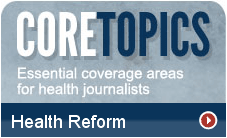Tag
nonprofits
-
Comprehensive series on N.C. hospitals includes national context, effects of reform
The (Raleigh, N.C.) News & Observer and The Charlotte (N.C.) Observer just combined forces to do a terrific five-part series…

-
Health Policy comes with new rules for nonprofit hospitals
When I first started covering health care, I thought that a nonprofit hospital was one that didn’t make any money.…

-
•
Report looks at nonprofits’ health reporting
Maralee Schwartz, a Shorenstein Center Fellow at Harvard University, has written a report titled “Getting It for Free: When Foundations…

-
Foundations’ role in Health Policy is changing
Some philanthropic foundations and think tanks in California are frustrated that efforts to finance studies and projects have done little…


